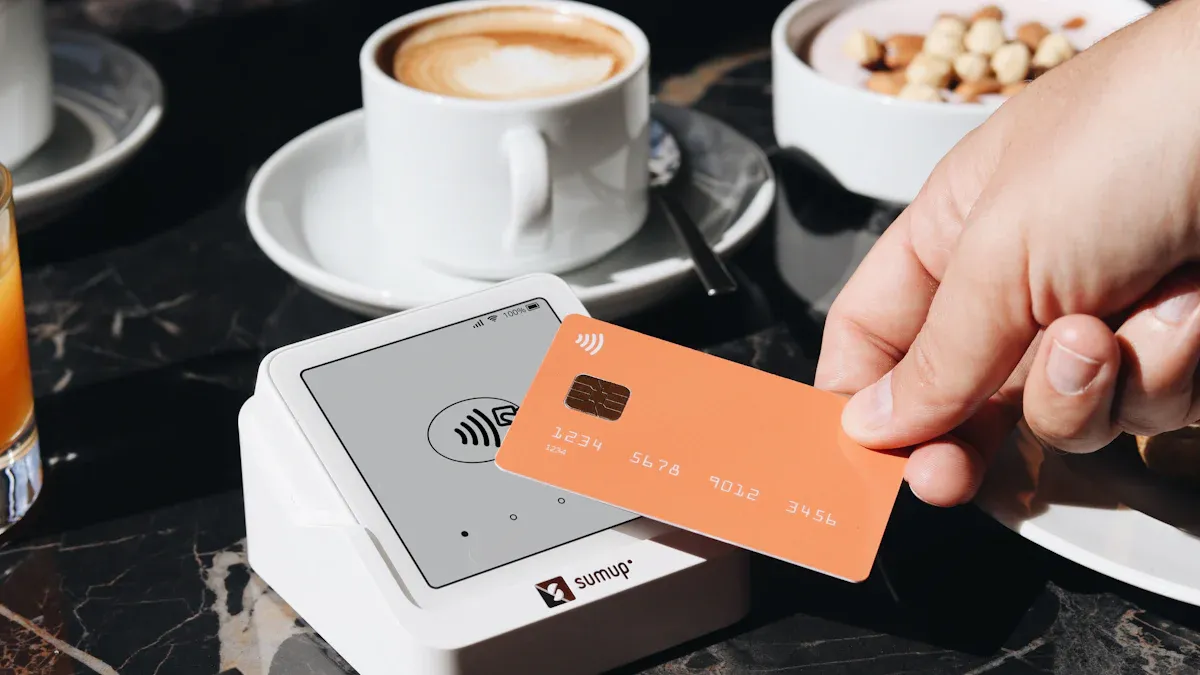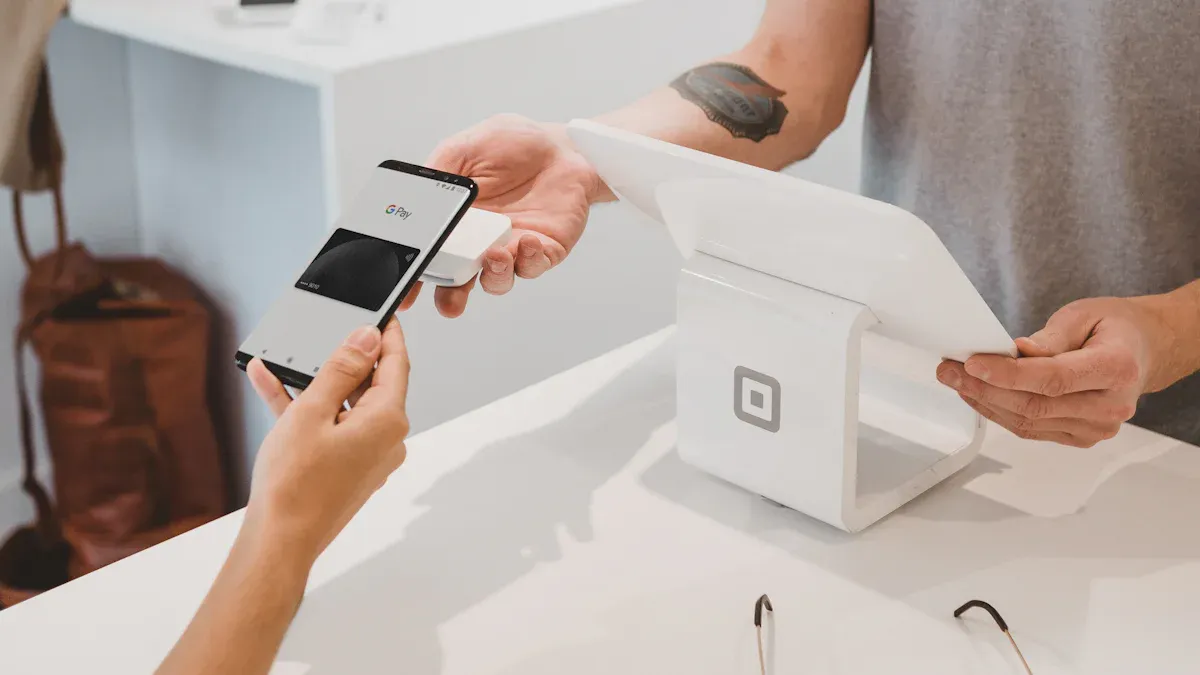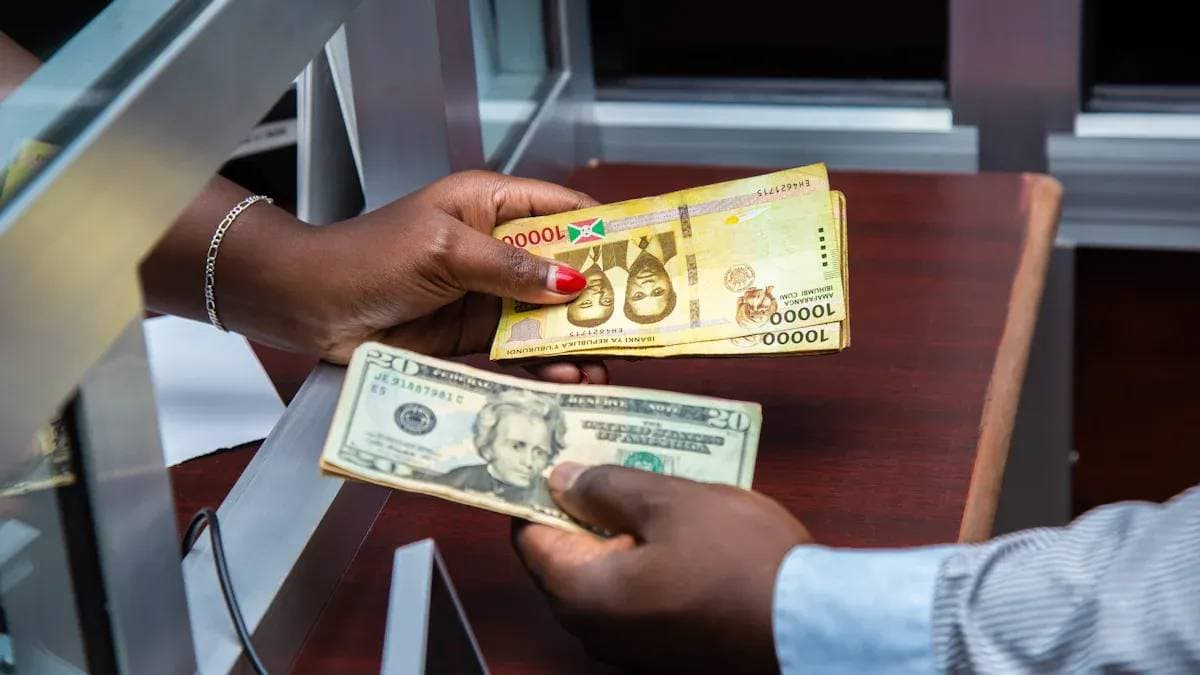- EasyCard
- Trade
- Help
- Announcement
- Academy
- SWIFT Code
- Iban Number
- Referral
- Customer Service
- Blog
- Creator
2025 Must-Read for Going Global: Ultimate Guide to Securely Choosing a Cross-Border Payment Platform

Image Source: unsplash
When you expand your business footprint globally, a secure and reliable cross-border payment platform becomes the lifeline of your success. The global e-commerce market in 2025 is growing rapidly, with predictions from different institutions revealing enormous market potential.
| Source | 2025 Market Size Forecast |
|---|---|
| Coherent Market Insights | $1.47 trillion |
| Precedence Research | $55.123 billion |
Facing opportunities, securing funds is the top priority. You need to evaluate and choose using five golden criteria: compliance certification, risk control capabilities, fund security, cost transparency, technical stability. These are the cornerstones ensuring your business runs smoothly.
Core Points
- When choosing a cross-border payment platform, you must check if it has legitimate licenses and security certifications.
- The platform must have strong technology to protect your money, such as multi-factor authentication and anti-fraud systems.
- Ensure your money is securely segregated and stored; even if the platform has issues, your funds remain safe.
- Carefully review all fees; don’t just look at surface-level low rates.
- The platform’s service must be stable, with customer support that can promptly help you resolve issues.
Five Security Cornerstones for Choosing a Cross-Border Payment Platform

Image Source: unsplash
Choosing a secure cross-border payment platform is like building a solid foundation for your global business. You need to scrutinize the following five core standards like a detective. Together, they form the golden criteria for evaluating platform security.
Standard One: Compliance and Qualification Certification
Compliance is the first line of defense for security and the most important one. A platform without a legitimate license is like an unregistered ship that could sink at any moment in the sea of regulation. You must check whether the platform holds operating permits in key markets.
Core Review Checklist:
- Target Market Licenses: Ensure the platform holds financial licenses in your primary sales markets.
- International Security Certifications: Verify if the platform has passed globally recognized security audits.
- Data Regulation Compliance: Confirm the platform adheres to strict data protection regulations.
For example, if your business targets the US, the platform should hold a US MSB (Money Services Business) license. Applying for this license requires:
- Registering with the US Treasury’s Financial Crimes Enforcement Network (FinCEN).
- Developing a written anti-money laundering (AML) compliance program.
- At the state level, typically providing surety bonds, financial statements, and passing criminal background checks.
If your market is in Europe, the platform needs an EMI (Electronic Money Institution) license. The standards for obtaining this license are equally strict:
- Must establish a physical office and local team in an EU country.
- Must prove ownership of at least $350,000 in initial capital.
- Must set up independent client fund accounts and submit detailed business plans and risk control schemes.
Beyond financial licenses, globally accepted security certifications are also critical. PCI DSS (Payment Card Industry Data Security Standard) is the core standard for protecting credit card information. You should prioritize platforms that achieve Level 1, the highest level of certification. This means the platform must:
- Undergo a comprehensive Report on Compliance (ROC) annually by an independent Qualified Security Assessor (QSA).
- Conduct network vulnerability scans quarterly by an Approved Scanning Vendor (ASV).
Finally, in terms of data privacy, check if the platform complies with GDPR (General Data Protection Regulation). This means when handling data from your European customers, the platform must:
- Obtain Consent: Must get clear user consent before processing data.
- Data Minimization: Collect only the minimum information necessary for transactions.
- Transparent Processing: Clearly inform users how data is used, stored, and protected.
- Breach Notification: In case of a data breach, must notify regulators and affected users within 72 hours.
Standard Two: Technical Security and Risk Control Capabilities
With compliance qualifications in place, next, check if the platform’s technical “muscle” is strong enough to withstand ever-changing online fraud and card-skimming attacks.
First is Multi-Factor Authentication (MFA). This adds a sturdy lock to your account. Even if the password is stolen, without the second verification (such as a phone code or fingerprint), fraudsters cannot log into your account. MFA not only protects your data and funds but is also a mandatory requirement to meet PCI DSS and other compliance standards.
Next is advanced transaction verification technology. 3D Secure 2.0 (3DS2) is a typical example. It enhances payment security by introducing smarter verification methods:
- Frictionless Verification: Risk assessment based on over 100 data points like device info and IP address; low-risk transactions pass directly without disturbing the user.
- Challenge Verification: When the system identifies high risk, it requires additional user verification, such as entering a one-time password or using biometrics (fingerprint, facial recognition).
More importantly, a top-tier platform deploys AI-driven anti-fraud monitoring systems. These systems analyze massive transaction data 7x24 hours without interruption and identify abnormal behavior patterns. For example, the system can analyze the user’s typing speed, mouse movement trajectory, and other “behavioral fingerprints” to issue alerts and block fraudulent transactions at the initial stage of account takeover.
Standard Three: Fund Processing and Settlement Security
How is your money stored after entering the payment platform? This is a matter of life and death. The most critical security mechanism is segregated client money bank custody.
What is fund segregation custody?
Simply put, the payment platform must store your pending settlement funds (client reserve funds) in an independent, regulated bank account. This account is completely separate from the platform’s own operational corporate funds account and is legally protected.
This mechanism is crucial because it ensures:
- Funds Cannot Be Misappropriated: The platform cannot use your funds for investments or to cover its own operating expenses.
- Protected in Bankruptcy: Even if the cross-border payment platform unfortunately goes bankrupt, the funds you have in the segregated account belong to you and will not be treated as the platform’s assets for liquidation, thus safeguarding your fund security.
In strictly regulated regions like the UK and EU, this is a legal requirement. For example, the UK’s Payment Services Regulations (PSRs) and the EU’s Payment Services Directive (PSD3) explicitly require payment institutions to store client funds in independent safeguarding accounts, and not place all funds in a single bank to diversify risk. When selecting a platform, you must confirm that the other party strictly complies with this regulation and can provide relevant bank proofs.
Standard Four: Cost Structure and Fee Transparency
Security not only refers to fund security but also financial predictability. Some platforms appear to have low rates but may hide various additional fees, ultimately eroding your profits.
You need to be wary of the following common “hidden fees”:
- Exchange Rate Markup: The difference between the platform’s offered exchange rate and the real-time market mid-rate; this is the most common hidden cost.
- Correspondent Bank Fees: In traditional wire transfers, intermediary banks through which funds pass may deduct a handling fee.
- Withdrawal Fees: Fees incurred when withdrawing funds from the platform to your bank account.
- Account Management Fees: Fixed fees charged monthly or annually regardless of transactions.
To make informed comparisons, you should calculate Total Cost of Ownership (TCO). This requires you to include all potential costs in your consideration.
| Cost Category | Included Items |
|---|---|
| Setup and Implementation Costs | Account opening fees, technical integration fees, employee training costs |
| Operating Costs | Transaction fees, exchange rate costs, withdrawal fees, monthly service fees |
| Growth and Expansion Costs | Rate changes after transaction volume increases, fees for opening new currency accounts |
| Exit Costs | Contract penalties for early account closure |
Only when you lay all fees out in the open can you truly see which platform offers the best cost-effectiveness for your business.
Standard Five: Service Stability and Technical Support
Imagine during the critical moment of Black Friday promotions, your payment page suddenly crashes—this would be a devastating blow. Therefore, the platform’s service stability is a security indicator that cannot be ignored.
You need to pay attention to the platform’s Service Level Agreement (SLA), looking for platforms that promise 99.9% or higher uptime. This means annual service downtime does not exceed a few hours.
Equally important is technical support. When you encounter transaction failures, account freezes, or technical integration issues, a professional customer service team that provides 7x24 hours support in Chinese will save you a lot of time and money. An excellent cross-border payment platform is not just a collection tool but your partner in solving payment problems. Before choosing, it’s advisable to personally test their customer service response speed and professionalism.
Choosing Cross-Border Payment Platforms for Different Business Scenarios

Image Source: unsplash
After selecting the basic security standards, you also need to match the most suitable payment solution based on your business model. Different businesses have vastly different payment needs. Below, we analyze three mainstream global scenarios to help you make more precise choices.
Scenario One: Independent Website Collection
Operating an independent website means you directly face global consumers, with the highest brand control, but you also bear all the risks of payment security and transaction fraud. Therefore, the chosen payment gateway must be like a sturdy fortress.
Core Security Needs for Independent Website Collection:
- Seamless Customer Experience: The payment process must be simple and fast, reducing customer abandonment at the final step.
- Strong Fraud Protection: Must proactively identify and block suspicious transactions to protect your revenue.
- Efficient Dispute Handling: Must have clear processes to handle customer chargebacks.
An excellent payment gateway provides multi-layer security guarantees. First, SSL/TLS encryption and PCI DSS compliance are the most basic configurations, ensuring absolute security of customer credit card information during transmission and processing. Second, Tokenization technology replaces sensitive card number information with a unique code (Token); even if data is stolen, hackers cannot obtain the real card information, fundamentally eliminating the risk of information leakage.
Chargebacks are one of the biggest headaches for independent website sellers. A reliable payment service provider offers clear processes and tools to help you manage them. Typically, the handling process is as follows:
- Your customer raises a dispute with their issuing bank.
- The issuing bank notifies the payment platform.
- The payment platform notifies you via email and requires you to submit evidence within the specified time (such as shipping proof, tracking number, customer communication records, etc.).
- You submit evidence through the platform backend.
- The issuing bank reviews and makes the final decision.
Note that handling chargebacks is time-consuming and costly. Some platforms, like Stripe, charge approximately $15.00 USD per dispute regardless of the outcome. If your account’s chargeback rate is too high (usually above 1%), the platform may set a reserve on your account, temporarily freezing a portion of sales to cover potential risks. Therefore, choosing a platform with powerful fraud prevention tools (like Stripe Radar) and chargeback protection plans is crucial.
Scenario Two: E-Commerce Platform Collection
If you operate stores on multiple e-commerce platforms like Amazon, eBay, Lazada, the biggest challenge is how to securely and low-cost aggregate funds scattered across platforms and ultimately withdraw to your bank account in China. At this point, you need professional third-party collection service providers.
The core value of such providers (like Payoneer, WorldFirst, PingPong) lies in:
- Providing Global Local Collection Accounts: They open virtual bank accounts in major currencies like USD, EUR, GBP, JPY for you. You can bind these account details to the backend of major e-commerce platforms, receiving platform payouts like a local seller, avoiding high fees and long waits of traditional wire transfers.
- Centralized Management of Multi-Platform Funds: You can clearly see inflows from all platforms in one backend, uniformly managing your global revenue.
- Compliant FX Settlement and Withdrawal: These platforms cooperate with banks or payment institutions in mainland China, providing compliant and transparent FX settlement paths, allowing you to safely convert foreign exchange income to RMB or directly withdraw to your USD account in a licensed Hong Kong bank.
In terms of security, you need to ensure the selected cross-border payment platform strictly complies with fund segregation regulations, storing your pending settlement funds in regulated bank escrow accounts. This guarantees that even if the platform itself encounters operational issues, your funds remain safe.
Scenario Three: B2B Large Trade Collection
The payment scenario for B2B trade is completely different from retail, characterized by large single amounts, low transaction frequency, and long payment cycles. This places higher demands on payment security and compliance.
In the past, bank wire transfer (T/T) was the mainstream choice for B2B transactions. It is sufficiently secure, but the drawbacks are also obvious:
- High Cost: Each international wire transfer typically incurs $15-$50 USD or higher fees, and funds passing through intermediary banks may be charged again.
- Slow Speed: A remittance takes 3-5 business days or longer to arrive, affecting capital turnover efficiency.
- Opaque Process: You cannot track fund status in real-time and find it difficult to provide clear payment proof to customers.
Today, professional B2B payment platforms (like Biyapay) offer better solutions for large trades. These platforms effectively solve the pain points of traditional wire transfers by integrating global banking networks and adopting innovative technologies.
Biyapay and other professional B2B platform advantages: They typically use blockchain and other technologies to provide users with a global clearing network. When you initiate a large transfer, the platform can achieve near-real-time fund movement while reducing transaction costs to a minimum. For example, the fee for a large transaction may be far lower than traditional bank wire transfers.
In terms of security, these platforms invest significant resources in building anti-money laundering (AML) compliance systems and AI-driven fraud monitoring systems. They can analyze transaction behavior in real-time, identify abnormal patterns, and alert and block high-risk transactions, helping your enterprise meet global regulatory requirements and avoid unintentionally getting involved in illegal transaction risks.
The table below clearly compares the differences between the two methods:
| Feature | Traditional Bank Wire Transfer (T/T) | Professional B2B Payment Platform (e.g., Biyapay) |
|---|---|---|
| Transaction Cost | High ($15 - $50 USD per transaction + intermediary bank fees) | Extremely low (usually proportional or fixed low fee) |
| Arrival Speed | Slow (3-5 business days) | Fast (can achieve near real-time or same-day arrival) |
| Fund Tracking | Difficult, opaque | Transparent, real-time tracking |
| Anti-Money Laundering (AML) | Relies on manual bank review, cumbersome process | Systematic, AI-driven automated compliance review |
| Operational Convenience | Requires filling complex forms, error-prone | Online operation, simple and fast |
For enterprises engaged in large B2B trade, choosing a professional payment platform that combines cost-effectiveness, high efficiency, and top-tier security compliance is a strategic decision to safeguard funds and enhance competitiveness.
Ultimate Security Operation Checklist
Choosing a platform is just the first step; daily security operations are the key to long-term fund protection. This checklist will guide you to build a solid self-defense line and proactively minimize risks.
Strengthen Account Access Security
Your payment platform account is the gateway to your fund vault and must be strictly guarded.
First, you need to create and use strong passwords. A secure password has at least 12 characters and mixes uppercase and lowercase letters, numbers, and symbols. Avoid using easily guessable information like birthdays or names. More importantly, set unique passwords for each platform and never reuse them. You can use a password manager to securely generate and store these complex passwords.
Second, you must enable Multi-Factor Authentication (MFA). This is equivalent to adding an extra lock to your account door. Even if hackers steal your password, without the second verification (such as a phone code or fingerprint), they cannot access your account.
Implement Proactive Transaction Monitoring
Do not completely rely on the platform’s automatic risk control; you also need to be the “detective” of your own business. Regularly check transaction records and watch for any abnormal signals.
Beware of these transaction red flags:
- Information Inconsistency: Obvious differences between the customer’s shipping address, billing address, and IP location.
- Abnormal Behavior: New customers placing orders far above average amounts, or using different credit cards from the same IP address in a short time.
- Testing Behavior: After a transaction fails, the customer immediately tries a smaller amount with the same card, likely testing the validity of a stolen credit card.
You can use platform-provided tools to set custom rules, such as automatically flagging orders exceeding a certain amount or from high-risk regions for manual review.
Ensure Compliant Business Operations
Your business model directly determines the payment risk level. Some industries are considered high-risk by payment institutions because they typically come with higher chargeback rates.
| Risk Factor | Business Model Examples |
|---|---|
| High Chargeback Rate | Subscription services, online gambling, nutritional supplements |
| High Fraud Rate | Free trials, online dating, adult entertainment |
| Strong Regulation | CBD products, e-cigarettes, online pharmacies |
Before cooperating with a payment platform, you must truthfully disclose your business type. Concealing the nature of your business may lead to account freezes or closures in the future, causing unnecessary losses.
Efficiently Handle Transaction Disputes
Transaction disputes (chargebacks) are an unavoidable part of cross-border e-commerce. When a dispute occurs, efficient and professional handling is key to recovering losses.
You must follow the standard process below:
- Immediate Response: You have very limited time to handle disputes, usually only a few days. You must act immediately upon receiving notification.
- Collect Evidence: Prepare all materials that prove the transaction is valid. This includes clear order screenshots, shipping proofs (such as tracking numbers), delivery proofs, and all communication records with the customer.
- Clear Rebuttal: Write a concise rebuttal letter, organize all evidence, and submit to the bank via the platform.
Remember, every dispute affects your account health. Proactive handling is not just to recover a single payment but to maintain a long-term cooperative relationship with the payment platform.
Choosing a secure cross-border payment platform is an important strategic decision. You need to comprehensively consider the five standards of compliance, risk control, cost, technology, and service.
Remember, there is no absolute “best” platform, only the one “most suitable” for your business.
Please use the standards and checklist in this article, combined with your business model, target market, and risk tolerance, to make the wisest choice. Make the right payment choice to escort your global business.
FAQ
How to start evaluating a platform’s security?
You should first check the platform’s compliance qualifications. Confirm whether it holds financial licenses and international security certifications in your target market, such as PCI DSS Level 1. This is the foundation for evaluating all other security standards, ensuring the platform operates within legal and regulatory frameworks.
What are the most critical security certifications?
You need to focus on two major categories. One is financial licenses, such as the US MSB or Europe’s EMI. The other is data security certifications, especially PCI DSS Level 1, which protects customer bank card information. These certifications are hard indicators of the platform’s legitimate and secure operation.
Why is my account frozen? What should I do?
Account freezes usually occur because transaction behavior triggers the platform’s risk control alerts or your business model is identified as high-risk. You should immediately contact platform customer service, clearly explain the situation, and submit all required proof materials as requested. Staying calm and professional in communication is crucial.
Are platforms with lower fees always the better choice?
Not necessarily. You must be wary of hidden fees, such as exchange rate markups or high withdrawal fees. You should calculate the Total Cost of Ownership (TCO) instead of just comparing surface transaction rates. A transparent cost structure is far more important than a seemingly low rate.
*This article is provided for general information purposes and does not constitute legal, tax or other professional advice from BiyaPay or its subsidiaries and its affiliates, and it is not intended as a substitute for obtaining advice from a financial advisor or any other professional.
We make no representations, warranties or warranties, express or implied, as to the accuracy, completeness or timeliness of the contents of this publication.




Contact Us
Company and Team
BiyaPay Products
Customer Services
BIYA GLOBAL LLC is a licensed entity registered with the U.S. Securities and Exchange Commission (SEC No.: 802-127417); a certified member of the Financial Industry Regulatory Authority (FINRA) (Central Registration Depository CRD No.: 325027); regulated by the Financial Industry Regulatory Authority (FINRA) and the U.S. Securities and Exchange Commission (SEC).
BIYA GLOBAL LLC is registered with the Financial Crimes Enforcement Network (FinCEN), an agency under the U.S. Department of the Treasury, as a Money Services Business (MSB), with registration number 31000218637349, and regulated by the Financial Crimes Enforcement Network (FinCEN).
BIYA GLOBAL LIMITED is a registered Financial Service Provider (FSP) in New Zealand, with registration number FSP1007221, and is also a registered member of the Financial Services Complaints Limited (FSCL), an independent dispute resolution scheme in New Zealand.



















